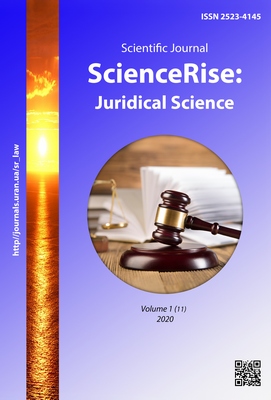Video conferencing in court proceedings by European Union legislation legal regulation
DOI:
https://doi.org/10.15587/2523-4153.2020.208016Keywords:
videoconference, litigation, law of the EU countries, European law, international lawAbstract
The scientific article is devoted to the videoconferencing in court proceedings by international law and the law of some European Union countries. The videoconferencing definition, the right to justice protection on the main international legal sources about the trial regulation and human rights to justice protection bases are studied, the procedural stages of court hearings by videoconference are analyzed.
Carrying out comparative legal research at our country present stage legal transformation and development, especially related to the emergence of new, modern legal relations, is primarily due to the need to receive international and foreign experience and, consequently, improve current national legislation.
It has been established, that the latest technologies introduction in the judicial process at the national and international levels has both advantages and disadvantages and is closely related to the protection and implementation of the right to justice. Normative legal acts about the right to justice consolidation are primary regarding the right of participants in court proceedings to participate in it by videoconference.
The attractive side of conducting court hearings online includes: the availability of litigation for all participants, regardless of their location, saving time and money, compliance with legal requirements for the duration of litigation, and so on.
Despite the general legal consolidation of the possibility of holding videoconferences in Ukraine and the EU, the procedural features of the rights and obligations of participants in such proceedings remain unclear, as well as unspecified issues regarding the application of different types of technical equipment depending on the conditions of video calls, the possibility of holding meetings outside the court in emergency conditions, etc.
References
- Syzonenko, A. (2003). Videozviazok yak zasib provedennia slidchykh dii za mezhamy Ukrainy. Pravo Ukrainy, 3, 96–99.
- Smyrnov, M. I. (2005). Osoblyvosti nadannia vzaiemnoi pravovoi dopomohy u kryminalnykh spravakh z vykorystanniam metodu videokonferentszviazku. Kyiv, 268.
- Zadyraka, N. Yu., Solodova, K. Yu. (2013). Zaprovadzhennia rezhymu video konferentsii v administratyvnomu sudochynstvi: problemy ta perspektyvy. Forum prava, 1, 318–322.
- Chernychenko, I. V. (2014). Perspektyvy vdoskonalennia videokonferentsii u kryminalnomu provadzhenni Ukrainy. Visnyk Chernivetskoho fakultetu Natsionalnoho universytetu «Odeska yurydychna akademiia», 1, 196–205.
- Zub, O. Yu. (2014). Videokonferentsiia yak zasib sproshchennia tsyvilnoho sudochynstva. Visnyk Kharkivskoho natsionalnoho universytetu imeni V. N. Karazina No. 1106. Seriia «PRAVO», 1, 219–222.
- Storony u spravi mozhut uziaty uchast u sudovomu zasidanni, ne vykhodiachy z kvartyry. Merezha pravovoho rozvytku. Available at: https://ldn.org.ua/event/storony-u-spravi-mozhut-uziaty-uchast-u-sudovomu-zasidanni-ne-vykhodiachy-z-kvartyry/
- Chernychenko, I. (2014). Poniattia ta protsesualno-pravova sut videokonfentsii u kryminalnomu provadzhenni Ukrainy. Visnyk Lvivskoho universytetu. Seriia yurydychna, 59, 365–369.
- Good Practices for the Protection of Witnesses in Criminal Proceedings Involving Organized Crime (2008). UNODC, 37.
- Vseobschaia deklaraciia prav cheloveka 1948 g. (2000). Mezhdunarodnye dokumenty po pravam cheloveka. Kharkiv: RIF «Arsin, LTD», 6–12.
- Mizhnarodnyi pakt pro hromadianski i politychni prava 1966 r.: Ratyfik. Ukazom Prezydii Verkhov. Rady URSR # 2148-VIII vid 19.10.73 r. (2000). Mezhdunarodnye dokumenty po pravam cheloveka. Kharkiv: RIF «Arsin, LTD», 64–85.
- Konventsiia pro zakhyst prav liudyny ta osnovopolozhnykh svobod 1950 roku (1998). Ofitsiinyi visnyk Ukrainy, 13, 270–302.
- Konventsiia pro likvidatsiiu vsikh form rasovoi dyskryminatsii vid 07.03.1996 r. (1969). Vedomosti Verkhovnogo Soveta SSSR, 25, 128–148.
- Konventsiia pro prava dytyny 1989 r. (1990). Vedomosti Sezda narodnykh deputatov SSSR i Verkhovnogo Soveta SSSR, 45, 955.
- Omelianenko, H. M. (2002). Provadzhennia u spravakh pro zlochyny nepovnolitnikh yak dyferentsiatsiia kryminalno-protsesualnoi formy. Kyiv: Atika, 75–102.
- Cherkes, M. Yu., Pohribnyi, S. A. (Eds.) (2002). Konventsiia pro status bizhentsiv vid 14.12.1950 r. Pravova rehlamentatsiia statusu bizhentsiv i osib, yaki shukaiut prytulku. Odesa: Latstar, 119–139.
- Bohunov, V. (2012). Videokonferentsii dozvoliat uchasnykam protsesu ekonomyty chas i hroshi. Zakon i biznes, 35 (1074). Available at: http://zib.com.ua/ua/11349-videokonferencii_dozvolyat_uchasnikam_sudovih_zasidan_ekonom.html
- Hariievska, M. B. (2015). Videokonferentsiia v tsyvilnomu protsesi. Pryvatne pravo i pidpryiemnytstvo, 14, 59–62. Available at: http://univer.km.ua/statti/7.hariyevska_m.b._videokonferentsiya_v_tsyvilnomu_protsesi_problemni_pytannya.pdf
- Note by the Secretariat. The technical and legal obstacles to the use of videoconferencing. Item 6 of the provisional agenda∗ International cooperation with particular emphasis on extradition, mutual legal assistance and international cooperation for the purpose of confiscation, and the establishment and strengthening of central authorities CTOC/COP/2010/CRP.2 P.4 Fifth session. Vienna, 2010.
- Kravcova, T., Kornienko, M. (2020). Sudebnye zasedaniia v rezhime videokonferencii. Ukrainskii iurist, 4-5. Available at: https://www.asterslaw.com/ru/press_center/publications/court_hearings_via_videoconferences_in_ukraine/
Downloads
Published
How to Cite
Issue
Section
License
Copyright (c) 2020 Ozernyuk Ganna

This work is licensed under a Creative Commons Attribution 4.0 International License.
Our journal abides by the Creative Commons CC BY copyright rights and permissions for open access journals.
Authors, who are published in this journal, agree to the following conditions:
1. The authors reserve the right to authorship of the work and pass the first publication right of this work to the journal under the terms of a Creative Commons CC BY, which allows others to freely distribute the published research with the obligatory reference to the authors of the original work and the first publication of the work in this journal.
2. The authors have the right to conclude separate supplement agreements that relate to non-exclusive work distribution in the form in which it has been published by the journal (for example, to upload the work to the online storage of the journal or publish it as part of a monograph), provided that the reference to the first publication of the work in this journal is included.









